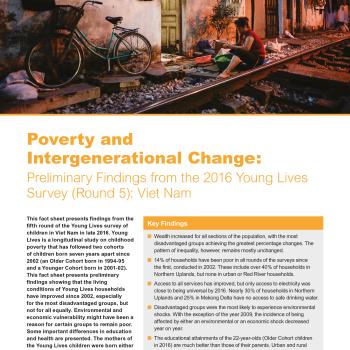Publication Information

Round 5 Longitudinal Poverty and Intergenerational Change Fact Sheet
This fact sheet presents findings from the fifth round of the Young Lives survey of children in Viet Nam in late 2016. Young Lives is a longitudinal study on childhood poverty that has followed two cohorts of children born seven years apart since 2002 (an Older Cohort born in 1994-95 and a Younger Cohort born in 2001-02). This fact sheet presents preliminary findings showing that the living conditions of Young Lives households have improved since 2002, especially for the most disadvantaged groups, but not for all equally. Environmental and economic vulnerability might have been a reason for certain groups to remain poor. Some important differences in education and health are presented. The mothers of the Young Lives children were born either in war time or in the decade preceding the economic renewal of Doi Moi; their children have grown up enjoying better nutrition, health care, and educational services in the post-Doi Moi era.
Key Findings:
Wealth increased for all sections of the population, with the most disadvantaged groups achieving the greatest percentage changes. The pattern of inequality, however, remains mostly unchanged.
14% of households have been poor in all rounds of the surveys since the first, conducted in 2002. These include over 40% of households in Northern Uplands, but none in urban or Red River households.
Access to all services has improved, but only access to electricity was close to being universal by 2016. Nearly 30% of households in Northern Uplands and 25% in Mekong Delta have no access to safe drinking water.
Disadvantaged groups were the most likely to experience environmental shocks. With the exception of the year 2009, the incidence of being affected by either an environmental or an economic shock decreased year on year.
The educational attainments of the 22-year-olds (Older Cohort children in 2016) are much better than those of their parents. Urban and rural locations are more equal in 2016 with respect to schooling and in post-secondary enrolment than was the case for their parents’ generation.
22-year-old women are on average 4cm taller than their mothers. The important factors associated with intergenerational differences in height are location, ethnicity, and the caregiver’s number of years of schooling.

Round 5 Longitudinal Poverty and Intergenerational Change Fact Sheet
This fact sheet presents findings from the fifth round of the Young Lives survey of children in Viet Nam in late 2016. Young Lives is a longitudinal study on childhood poverty that has followed two cohorts of children born seven years apart since 2002 (an Older Cohort born in 1994-95 and a Younger Cohort born in 2001-02). This fact sheet presents preliminary findings showing that the living conditions of Young Lives households have improved since 2002, especially for the most disadvantaged groups, but not for all equally. Environmental and economic vulnerability might have been a reason for certain groups to remain poor. Some important differences in education and health are presented. The mothers of the Young Lives children were born either in war time or in the decade preceding the economic renewal of Doi Moi; their children have grown up enjoying better nutrition, health care, and educational services in the post-Doi Moi era.
Key Findings:
Wealth increased for all sections of the population, with the most disadvantaged groups achieving the greatest percentage changes. The pattern of inequality, however, remains mostly unchanged.
14% of households have been poor in all rounds of the surveys since the first, conducted in 2002. These include over 40% of households in Northern Uplands, but none in urban or Red River households.
Access to all services has improved, but only access to electricity was close to being universal by 2016. Nearly 30% of households in Northern Uplands and 25% in Mekong Delta have no access to safe drinking water.
Disadvantaged groups were the most likely to experience environmental shocks. With the exception of the year 2009, the incidence of being affected by either an environmental or an economic shock decreased year on year.
The educational attainments of the 22-year-olds (Older Cohort children in 2016) are much better than those of their parents. Urban and rural locations are more equal in 2016 with respect to schooling and in post-secondary enrolment than was the case for their parents’ generation.
22-year-old women are on average 4cm taller than their mothers. The important factors associated with intergenerational differences in height are location, ethnicity, and the caregiver’s number of years of schooling.

